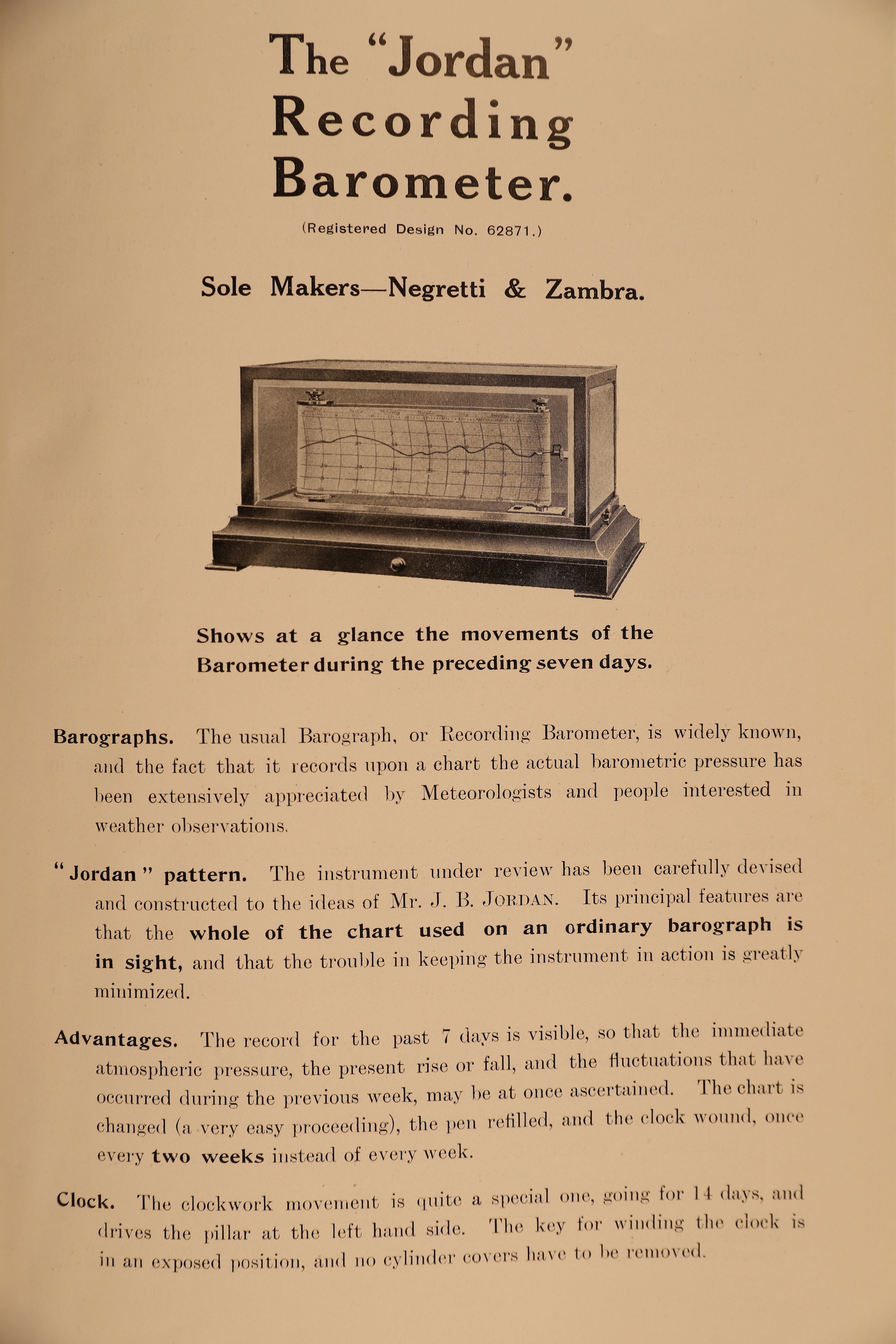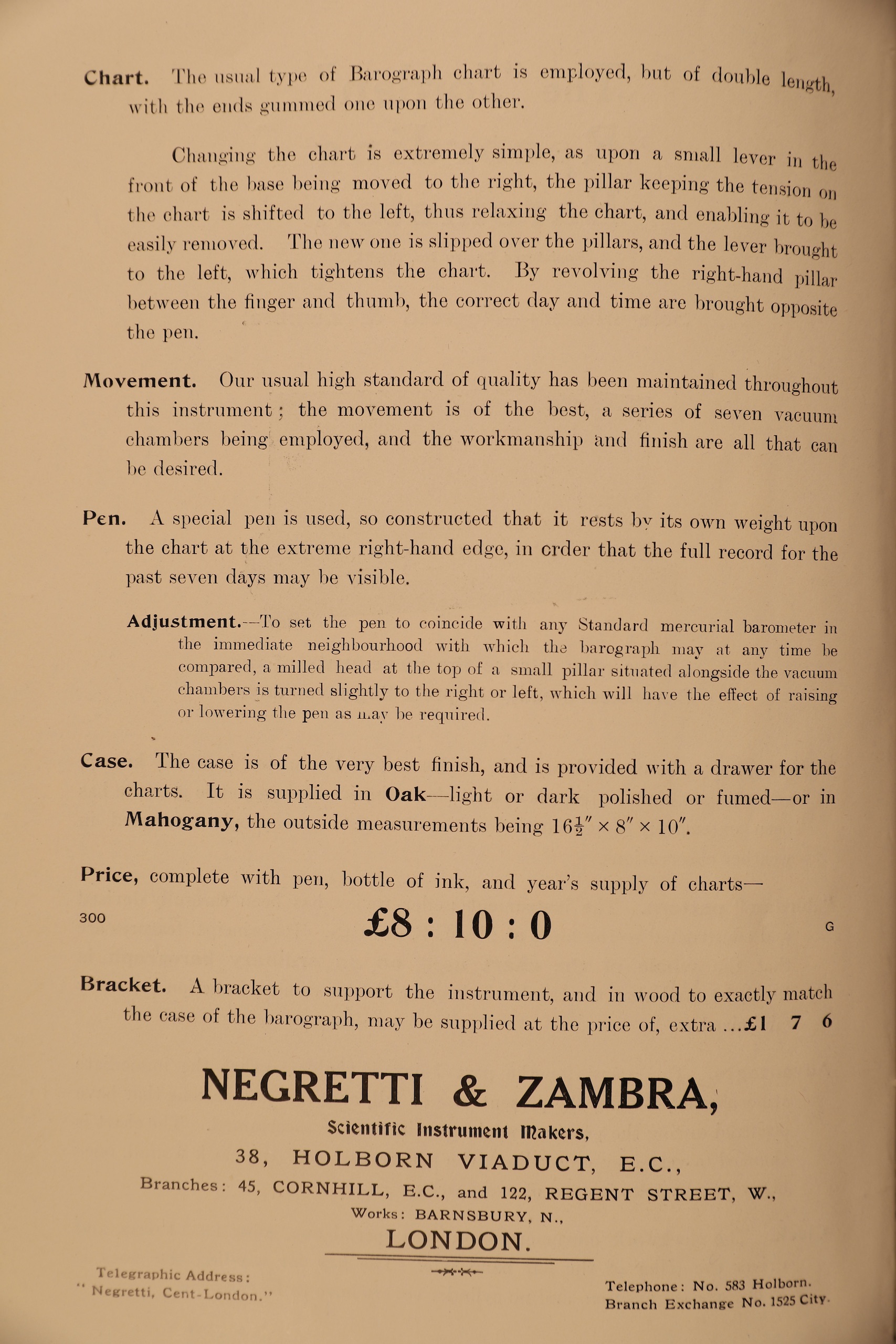A very unusual five-glass light oak “Jordan” seven day display recording barometer or barograph no. 863 by Negretti & Zambra c1915
Barograph having, to the left, spigot mounted drive roller with engine turned surface, release knob to top, driven gear to base; to the right, spigot mounted tensioning roller, release knob to top, the base connected to spring loaded front mounted tensioning lever. Enclosed 14 day clockwork transport motor, captive key, sliding dust shroud with regulation lever below.
Conventional barograph design having seven autonomous capsule pressure sensing stack, the movement raised on four turned pillars over a full length chassis bearing the legend “The “Jordan” Barograph, Regd. Design No. 62871,” instrument no. “863,” and “Sole Makers, Negretti & Zambra, London” with “N&Z” logogram. Zero or calibration correction stem, bespoke brushed aluminium recording arm, position setting screw at base, swinging nib.
Presented on an oak plinth, frieze drawer below, hinged oak cover with locking catch, heavy bevelled glasses.
Condition: Received “as found,” in other words not got at! A full and comprehensive re-build, conservation and testing followed, bringing this up to a high standard. All finishes remain original other than the tension roller guides (re-lacquered), the nib, a bespoke inhouse replacement, one end glass and rear glass replaced with exact patterns. Some minor losses to timber edges of cover, the access point to the cover catch re-carved, losses to lacquered chassis, and very slight marks to top glass.
Working well and responding to small pressure changes, see performance chart from dynamic test. A very good instrument.
Comments: One of the most sought after of all the various barograph designs, these instruments were published in the N&Z catalogue c1912 as “under review” – by the N&Z catalogue of c1915, the “Jordan” was a fully-fledged instrument for sale at a price of £8:10:0.
Immediately obvious as a perfect solution to the standard drum type which only afforded easy viewing of perhaps a day’s values, these instruments could display those of a full seven days, the paper long enough to record for 14. Having re-built several of these instruments, it is clear that this was by no means a mainstream product – small differences in production engineering not normally associated with volume are evident, and these instruments are rarely encountered, entirely consistent with low volume or small batch production runs. The serial number probably does not reflect an unbroken manufacture of this specific instrument but is likely shared with others of that period. It is likely, based on those that have survived, that production was limited to the low 100s.
If properly attended to and understood by the user, this is a very competent instrument. Its undoing, and probably a major factor in its limited take up, revolved around the nib, originally a small glass saxophone-shaped object, the mouthpiece of which drew ink by capillary action to the paper – this design was certainly flawed by blockage and coagulation. Other issues related to reliable paper transport obviously came to the fore, the paper tension, a clean dry transport roller and a freely rotating tension roller essential. This is a more complicated instrument to operate than a drum barograph.
The supply of suitable chart papers was a major issue. However, after lengthy enquiry and experiment, a solution has been found and papers calibrated in Mb may now be cut from a roll and easily fitted, see image below. As an additional benefit, this paper has a very low friction surface, greatly assisting the rise and fall of the nib.
This instrument continues to draw many design cues from the Richard Frères barographs that Negretti & Zambra first retailed, those details including the steel cross beams, the chassis mounted calibration stem, and associated mechanical attributes including the pressure sensing stack mounted onto a sub chassis leaf spring.
A really fascinating, rare and very desirable collector’s piece.
NB: The barograph will be supplied with a quantity of Mb charts, as described above, and ink.
James B. Jordan worked at the British Home Office, and was the inventor of the Jordan Sunshine Recorder, presented to the Royal Meteorological Society in 1885. He was the grandson of Thomas Brown Jordan, who pioneered the use of photography in meteorology in the 1830s.
Dimensions: 16½" wide x 9¾" deep x 8½" high
Stock No: BG2338
Price: £2500





